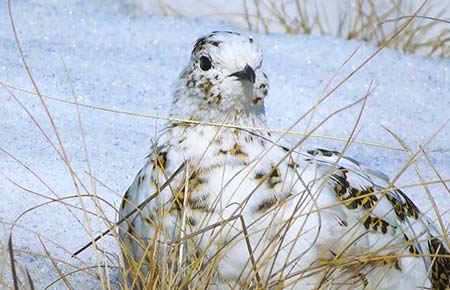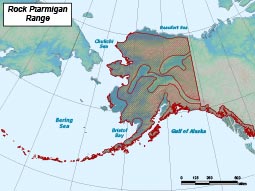Rock Ptarmigan
(Lagopus muta)
Species Profile
Did You Know?
Ptarmigan turn white in winter and brown in summer.
General Description
Larger than white-tailed ptarmigan and smaller than willow ptarmigan, rock ptarmigan develop their winter plumage early in October in central and northern Alaska, and are still predominantly white until early to mid-June. Cocks have a black mask from bill to eye in winter, effectively contrasting with their bright red, fleshy eyebrow and white body plumage. Hens have no mask, but about one female in five has a partial black stripe fore and aft of the eye. As is the case in willow ptarmigan, both sexes have black tail feathers tipped with white. However, the rock ptarmigan’s much narrower bill and smaller body size clearly distinguishes it from the willow ptarmigan.
By early May, female rock ptarmigan begin to show their new, brown summer plumage. When the hens begin incubating their clutch late in May, they are completely brown except for their white wings. Males keep the winter plumage until early June, then molt quickly to the finely-barred, dark brown summer plumage. However, the subspecies of rock ptarmigan found in the Aleutian Islands are an exception. There, the males actually begin getting brown feathers (almost black feathers in the Near Islands) by late March before the female plumage change.
Life History
Growth and Reproduction
Driven by their reproductive urge, cocks become less and less tolerant of each other throughout March and April. In early spring, males stake claims to parcels of ground that they defend in good weather, but spring snowstorms will send these males back into flocks. By late April or early May, males establish permanent territories that they defend in fair weather or foul. Hens arrive on the breeding grounds a bit later than males and then select their mates and nesting areas (often the same ones used the previous year). Males usually remain monogamous within a breeding season. However, males can be found with two females. By late May the first eggs are laid often on the open tundra with only a little grass or herbaceous cover for visual protection. The cocks stay on their territories throughout June, although the intense strutting, tail-fanning and aerial chasing typical of the courtship period wanes after the hens begin to incubate their clutch. Clutch sizes average between six to twelve and hens incubate for about 21 days. Most Alaskan ptarmigan chicks hatch from mid to late June.
Nests of rock ptarmigan consist of a scratched-out depression that may be lined with moss, lichen, grass, and the female’s breast feathers. They are often located out on the open tundra with minimal vegetation to offer any protection. Eggs are laid at intervals of 24 to 30 hours with full clutches usually containing six to twelve eggs; the number in a clutch varies not only with the individual but from year to year as well. Incubation lasts from 20 to 22 days. Nests are used only once. Re-nesting (second attempts to nest made when the first nest is destroyed) does occur but is generally rare.
Chicks hatch late from mid to late June in most of the state. In warm weather the hen leads the chicks from the nest about 12 hours after they hatch. The young live off nutrients stored in their bodies for a day or two after hatching, while learning to peck at bits of food shown to them by their mothers. The phenomenal growth and development of young ptarmigan during the first month of life is proof that the chicks learn the lessons of food-gathering very well. They double or triple their weight in ten days, and develop a working set of flight feathers during that time.
Hens erratically lead their broods from one good location to another, usually staying within one-half mile of the nest. Chicks normally stay with their parent until late August, but in crowded brood-rearing areas some exchanges of chicks may take place.
Feeding Ecology
From October through March, Alaskan rock ptarmigan eat mostly buds and catkins of dwarf birch; or, in the case of Aleutian birds, tips of crowberry plants. In April, rock ptarmigan (as well as the other ptarmigan species) begin to eat overwintered berries along with buds and catkins.
When the warming sun of May brings life to the buds of bearberry, mountain avens, and lousewort, and sends the first spiders scuttling out across the wet snow, ptarmigan are quick to change their diet. By late June they eat plants and insects exclusively. Northern summers are brief; by mid-August the ptarmigan turn to berries and seeds and by late October ptarmigan crops are again bulging with dwarf-birch buds and catkins.
Migration
Throughout September flocks of rock ptarmigan numbering from 20 to over 250 birds gather and move from place to place. At the end of this period, in which various local populations mix, flocks of mostly females move to their low-elevation wintering areas.
Winter flocks appear to be nomadic, wandering from place to place according to weather, snow conditions, food supply, and perhaps other impulses. Eating, avoiding predators, snow burrowing, and waiting out storms are daily winter activities. Rock ptarmigan can be seen eating, almost frantically, for much of the day, depending on day length. As days grow longer in February, it is not uncommon to find rock ptarmigan roosting or loafing for a portion of the midday. Rock ptarmigan must eat the equivalent in food of one-tenth to one-fifth of their body weight each day.
Range and Habitat
Rock ptarmigan occur throughout most of Alaska. They can be found from the northern Brooks Range south throughout Southeast Alaska. Rock ptarmigan are the only Alaskan ptarmigan species to occur on the Aleutian Islands.
Rock ptarmigan breed on hilly or mountainous tundra throughout Alaska. They appear to prefer very low herbaceous, and dwarf alpine plants are intermingled with rock and gravel ridges and alpine valley. The summer range of rock ptarmigan often abuts willow ptarmigan range, with rock ptarmigan breeding on higher, drier, rockier ground. In winter most male rock ptarmigan are at the lower edge of their breeding range. The hens move to the hills fringing large valleys, where they spend the winter in shrubby, open habitat.
Several subspecies of rock ptarmigan live throughout the entire Aleutian Islands. On all except for Unimak Island, only one subspecies occurs on each island. These birds live in much different habitat than mainland birds. Aleutian rock ptarmigan range down to sea level, and are found on coastal grassy areas and on gentle to moderate slopes consisting predominantly of low forbes.
Rock ptarmigan also live in Canada, Scandinavia, Scotland, and northern Eurasia. They range through most of Greenland and Iceland and have scattered southern outposts in Japan, Switzerland, and Spain. In Alaska, rock ptarmigan live in all major treeless areas except the flat tundras of the western and extreme northern coasts.
Like the other ptarmigan species, rock ptarmigan nests in mostly treeless areas.
Status, Trends, and Threats
Status
- NatureServe: G5
- IUCN: LC (Least Concern)
Trends
Ptarmigan are notorious for their here-today, gone-tomorrow populations, pulsing between superabundance and virtual absence in just a few years. The causes of the rapid population changes remain a mystery. Many people think that ptarmigan numbers fluctuate rhythmically, with peaks once every nine or 10 years. Although there is good evidence for these cycles in Iceland, cycles are more legend than proven fact in Alaska. As with many other grouse, the population depends very heavily on each year’s production of chicks, since this year’s chicks will be next year’s breeding stock. Under these conditions, one or two years of poor reproduction, a cold wet spring, or high winter losses can cause drastic declines in abundance. Conversely, one or two good years might result in more ptarmigan than you could swing a shotgun at.
Threats
Despite all of this care, young ptarmigan encounter many things that can kill them unless they are vigorous and lucky. Poor weather too soon after hatching, the quick pounce of the fox or the swift swoop of the hawk, chance separation from the family, and diseases like coccidiosis, all can be fatal. In most years, 65 to 80 percent of all chicks die before they are 11 months old. A ptarmigan’s life expectancy brightens a little once it reaches maturity since adults die at the rate of about 50 to 60 percent per year. At that rate, a 4-yearold ptarmigan is a fortunate bird. The abundance of ptarmigan at any time is the result of the reproductive success minus the deaths during the previous two years. Ptarmigan numbers can build up with astonishing speed given favorable conditions, but often decline just as rapidly.
Fast Facts
-
Size
Weight: 15 ounces (about 1 pound)
Wingspan: 17–20 inches -
Lifespan
2–4 years -
Range/Distribution
Alpine and arctic tundra throughout Alaska -
Diet
Buds, twigs, and catkins of dwarf birch, berries, insects and spiders in summer -
Predators
Crows, ravens, magpies, red foxes, pine martens, mink, short-tailed weasels, least weasels, gulls, northern harriers, golden eagles, bald eagles, rough-legged hawks, gyrfalcons, peregrine falcons, northern goshawks, snowy owls, wolverine, wolves, Arctic foxes, lynx and polar bears -
Reproduction
Breed annually in the spring, females lay six to 12 eggs which hatch after about three weeks


